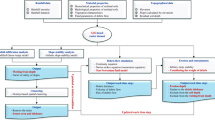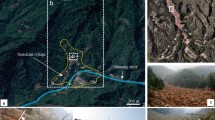Abstract
The Campanian Apennines are characterized by the presence of monocline ridges, mainly formed by limestone. During the periods of volcanic activity of the Somma-Vesuvius and Phlegrean Fields, the ridges were mantled with pyroclastic materials in varying thickness. The pyroclastics have been involved in destructive landslides both in historical time and in the recent past (1997, 1998, 1999). The landslides occur following intense and prolonged rainfalls. In some cases, landslides extended up to 4 km into the surrounding lowlands and reached towns, causing severe destruction and over 200 deaths. Generally, the landslides begin as small debris slides that develop into large, shallow debris avalanches or debris flows involving pyroclastic horizons and colluvial soils (0.5–2 m thick) on steep and vegetated slopes, often at the heads of gullies. During motion, the landslide materials eroded vegetation and soils from the slope, so that the moving material volume tended to increase. Then, proceeding towards and beyond the base of the slopes, the phenomena evolved into hyperconcentrated streamflow due to dilution by incorporating water. The results of motion analyses are described. An empirical rheological relationship was used including two principal terms that depend on the total normal stress and on the flow velocity. On this basis, the model has simulated the velocity and duration of debris avalanches and the distribution of the deposits. The selected areas were those of Sarno/Quindici and Cervinara, where a large amount of data is available both on the material properties and geomorphological setting. It was found that the majority of the cases at the two sites can be simulated successfully with only one specific pair of rheologic parameters. This provides the possibility for first-order predictions to be made of the motion of future landslides. Such predictions will be a valuable tool for outlining potential hazard areas and designing remedial measures.
















Similar content being viewed by others
References
Amanti M, Ducci D, Onorati G, Ventura R (1999) Relazione tra gli eventi franosi del maggio 1998 e la piovosità dell'area di Sarno. Atti dei convegni dei Lincei 154: Il rischio idrogeologico e la difesa del suolo. Roma 1–2 Ottobre, 1998, pp 73–80
Ayotte D, Evans N, Hungr O (1999) Runout analysis of debris flows and avalanches in Hong Kong. Slope stability and landslides. Proceedings of the Vancouver Geotechnical Society Symposium May, 1999, pp 39–46
Ayotte D, Hungr O (2000) Calibration of a runout prediction model for debris-flows and avalanches. In: Wieczorek G, Naeser (eds) Debris-flows hazards mitigation: mechanics, prediction, and assessment. Proc 2nd Int Conf on Debris Flows, Taipei. Balkema, Rotterdam, pp 505–514
Bagnold RA (1954). Experiments on a gravity-free dispersion of large solid spheres in a Newtonian fluid under shear. Proc R Soc Lond Ser A 255:49–63
Calcaterra D, Santo A, De Riso R, Budetta P, Di Crescenzo G, Franco I, Galietta G, Iovinelli R, Napolitano P, Palma B (1997) Fenomeni franosi connessi all'evento pluviometrico del gennaio 1997 in Penisola Sorrentina. Atti del IX Congresso Nazionale Geologi, Roma, 17–20 Aprile 1997, pp 223–231
Calcaterra D, Parise M, Palma B, Palella L (2000) The influence of meteoric events in triggering shallow landslides in pyroclastic deposits of Campania, Italy. Proc 8th Int Symp Landslides, Cardiff, 1, pp 209–214
Celico P, Aquino S, Esposito L, Piscopo V (2000) Problematiche idrogeologiche connesse con i fenomeni di instabilità delle coltri piroclastiche della dorsale di Pizzo d'Alvano. Quad Geol Appl 7(2):167–187
Celico P, Guadagno FM (1998) L'instabilità delle coltri piroclastiche delle dorsali carbonatiche in Campania: attuali conoscenze. Quad Geol Appl 5(1):129–188
Celico P, Guadagno FM, Vallario A (1986) Proposta di un modello interpretativo per lo studio delle frane nei terreni piroclastici. Geol Appl ed Idrogeologia 21:173–193
Chen H, Lee CF (2000) Numerical simulation of debris flows. Can Geotech J 37:146–160
Chirico GB, Claps P, Rossi F, Villani P (2000) Hydrologic condition leading to debris-flow initiation in the Campanian volcanoclastic soil. Proc EGS Plinius Conf, Maratea, October 1999, pp 473–484
Chow VT (1959) Open-channel hydraulics. McGraw-Hill, New York, 680 pp
Crosta GB, Dal Negro P (2003) Observations and modelling of soil slip-debris flow initiation processes in pyroclastic deposits: the Sarno 1998 event. Nat Hazards Earth Syst Sci 3:53–69
De Vita P (2000) Fenomeni di instabilità delle coperture piroclastiche dei Monti Lattari, di Sarno e di Salerno (Campania) ed analisi degli eventi pluviometrici determinanti. Quad Geol Appl 7(2):213–235
Del Prete M, Guadagno FM, Hawkins B (1998) Preliminary report on the landslides of 5 May 1998, Campania, southern Italy. Bull Eng Geol Environ 57:113–129
Esposito L, Guadagno FM (1998) Some special geotechnical properties of pumice deposits. Bull Eng Geol Environ 57:41–50
Faella C, Nigro E (2001a) Effetti delle colate rapide sulle costruzioni. Parte Prima: Descrizione del danno. Forum per il Rischio Idrogeologico "Fenomeni di colata rapida di fango nel Maggio '98", Napoli, 22 giugno 2001:105–112
Faella C, Nigro E (2001b) Effetti delle colate rapide sulle costruzioni. Parte Seconda: Valutazione della velocità di impatto. Forum per il Rischio Idrogeologico "Fenomeni di colata rapida di fango nel Maggio '98", Napoli, 22 giugno 2001, pp 113–125
Fiorillo F, Guadagno FM, Aquino S, De Blasio A, (2001). The December 1999 Cervinara landslides: further debris flows in the pyroclastic deposits of Campania (southern Italy). Bull Eng Geol Environ 60(3):171–184
Guadagno FM (1991) Debris flows in the Campanian volcaniclastic soil. Slope stability engineering. Thomas Telford (ed), London, pp 109–114
Guadagno FM (2000) The landslides of 5th May 1998 in Campania, Southern Italy: natural disasters or also man-induced phenomena? J Nepal Geol Soc 22:463–470
Guadagno FM, Magaldi S (2000) Considerazioni sulle proprietà geotecniche dei suoli allofanici di copertura delle dorsali carbonatiche Campane. Quad Geol Appl 7(2):143–155
Guadagno FM, Forte R, Revellino P, Fiorillo F, Focareta M (2003a) Some aspects of the initiation of debris avalanches in the Campania Region: the role of morphological slope discontinuities and the development of failure. Geomorphology (in press)
Guadagno FM, Martino S, Scarascia Mugnozza G (2003b) Influence of man-made cuts on the stability of pyroclastic covers (Campania—southern Italy): a numerical modelling approach. Environ Geol 43:371–384
Hungr O (1995) A model for the runout analysis of rapid flow slides, debris flows, and avalanches. Can Geotech J 32:610–623
Hungr O, Evans SG (1997) A dynamic model for landslides with changing mass. Proceedings of the International Association of Engineering Geology Symposium on engineering geology and the environment. Athens, Greece, 1, pp 719–724
Hungr O, Evans SG, Bovis M, Hutchinson JN (2001) Review of the classification of landslides of the flow type. Environ Eng Geosci 7(3):1–18
Ippolito F, D'Argenio B, Pescatore TS, Scandone P (1975) Structural-stratigraphic units and tectonic framework of Southern Apennines. In: Squyres C (ed) Geology of Italy. Earth Sci Soc Lybian Arab Republ, Tripoli, pp 317–328
Johnson AM (1984) Debris flows. In: Brudsen D, Prior DE (eds) Slope instability. Wiley, London, pp 257–361
Maeda T, Takenake H, Warkentin BP (1977) Physical properties of allophane soils. Adv Agron 29:229–264
Mazzarella A, Martone M, Tranfaglia G (2000) Il recente evento alluvionale del 4–5 maggio 1998 nel sarnese e il deficit risolutivo della rete pluviometrica. Quad Geol Appl 7(2):203–211
Onorati G, Braca G, Iritano G (1999) Evento idrologico del 4, 5 e 6 Maggio 1998 in Campania. Monitoraggio ed analisi idrologica. Atti dei convegni dei Lincei 154: Il rischio idrogeologico e la difesa del suolo. Roma 1–2 Ottobre 1998, pp 103–108
Pierson TC, Costa JE (1987) A rheological classification of sub-aerial sediment-water flows. Geol Soc Am Rev Eng Geol 7:1–12
Revellino P, Hungr O, Guadagno FM, Evans SG (2002) Dynamic analysis of recent destructive debris flows and debris avalanches in pyroclastic deposits, Campania region, Italy. International Conference on instability—planning and management. Ventnor, May 2002, pp 363–371
Rolandi G, Bartollini F, Cozzolino G, Esposito N, Sannino D (2000) Sull'origine delle coltri piroclastiche presenti sul versante occidentale del Pizzo d'Alvano (Sarno-Campania). Quad Geol Appl 7(1):37–47
Rosi M, Sbrana A (1987) The Campanian ignimbrite. In: Rosi M, Sbrana A (eds) Phleagrean fields. Quad Ric Sci CNR 9 (114):13–14
Rossi F, Chirico GB (1998) Definizione delle soglie pluviometriche di allarme. Rapporto Unità Operativa 2.38, C.N.R.- G.N.D.C.I., Salerno
Sassa K (1984) The mechanism starting liquefied landslides and debris flows. Proc 4th Int Symp on Landslides, Toronto, 2, pp 349–354
Sharpe CFS (1938) Landslide and related phenomena. Columbia Univ Press, New York, 137 pp
Soil Survey Staff (1975) Soil taxonomy: a basic system of soil classification for making and interpreting soil surveys. Agricultural handbook no 436. US Department of Agriculture, Soil Conservation Service, Washington, DC
Soil Survey Staff (1992) Keys to soil taxonomy, 5th edn. US Department of Agriculture, Pocahontas Press, Blacksburg, VA
Terribile A, Basile A, di Gennaro A, Aronne A, Buonanno M, De Mascellis R, Vingiani S, Mulacelli F (1999) The soil of the landslide of Sarno and Quindici. In: Proc Symp on degradation processes in volcanic soils. University of Napoli, pp 48–64
Voellmy A (1955) Über die Zerstörungskraft von Lawinen Schweiz Bauzeitung 73:212–285
Acknowledgements
The authors wish to thank the Fire Department of Campania (Corpo Nazionale dei Vigili del Fuoco–Centro di Documentazione di Napoli) for aerial photos. The research was supported by CNR-GNDGI grants (U-O. 2.34 F. M. Guadagno) and by Campania Region grants. This paper is GNDGI publication no. 2631.
Author information
Authors and Affiliations
Corresponding author
Rights and permissions
About this article
Cite this article
Revellino, P., Hungr, O., Guadagno, F.M. et al. Velocity and runout simulation of destructive debris flows and debris avalanches in pyroclastic deposits, Campania region, Italy. Env Geol 45, 295–311 (2004). https://doi.org/10.1007/s00254-003-0885-z
Received:
Accepted:
Published:
Issue Date:
DOI: https://doi.org/10.1007/s00254-003-0885-z




